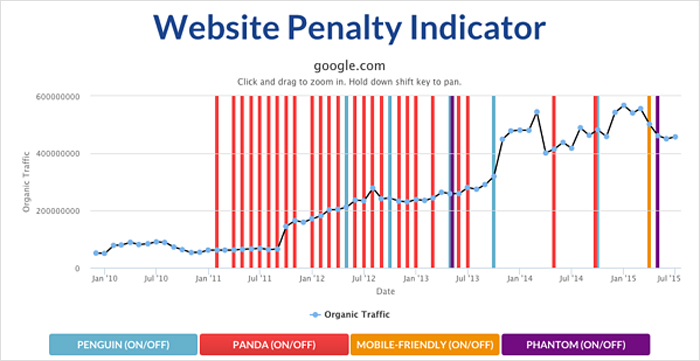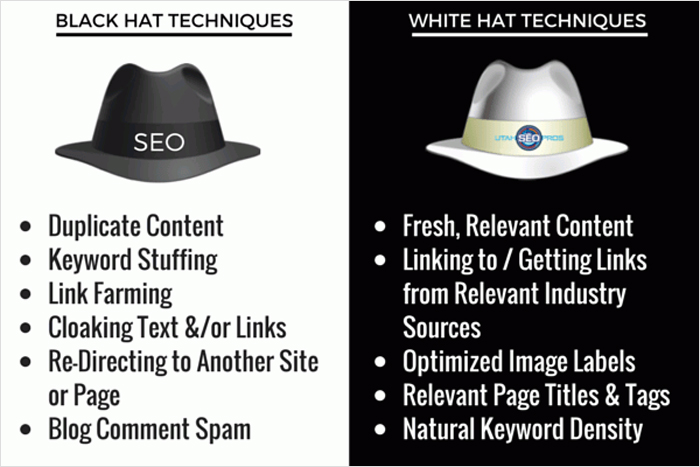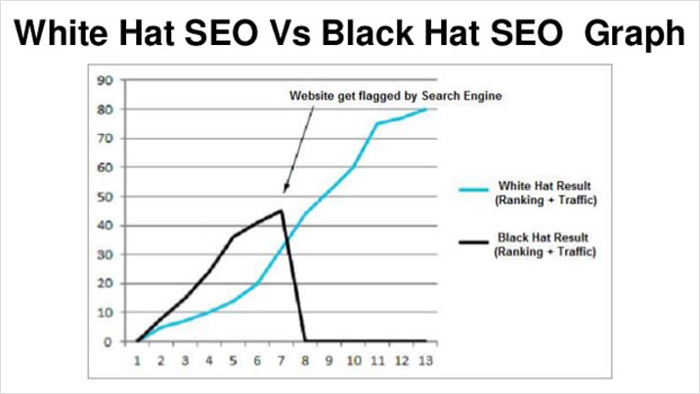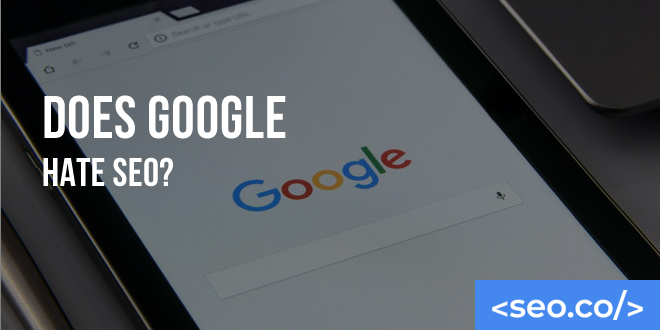It’s remarkably easy to think of Google as a person.
Especially now that we often communicate with Google directly using our voice.
“OK Google, do you hate me?”

In this sense, in the world of search engine optimization (SEO), our work is largely focused on “making Google happy.” Basically, we know that Google prioritizes certain web sites over others with its ranking algorithm. By doing things that Google likes, we can make Google “happy,” and therefore increase our chances of ranking higher in the SERPs.
It’s almost like appeasing the Search Gods—which is a surprisingly common analogy.
Google hates SEO strategies that defy the company’s guidelines.
We also know that Google is constantly fighting back against common SEO tactics; it introduces new penalties on a semi-regular basis to remove or de-rank webpages it deems as manipulative. Plus, its updates usually cause headaches for search optimizers all over the world; whenever Google decides it’s going to use new criteria to rank websites, optimizers have to work frantically to change up their strategies.
With this information, it’s easy to understand why so many people have the sentiment that Google “hates” SEO. But does it really?
Table of Contents
What Does Google Want?
Let’s start with a simple evaluation of Google’s motivation. Google is a company and a search engine, so it doesn’t “like” things the way you and I like things. It doesn’t have a favorite movie, or a favorite drink. It does, however, have preferences and motivations.
First and foremost, Google is motivated to make a profit. It makes profit with the help of advertising, and it gets more money from advertising when more people use the search engine. So Google is inherently motivated to get as many people using the search engine as consistently as possible.
How does it do this? By making people happy with the results they get.
Google’s bottom-line motivation, then, is to give users the best possible results for their search queries. And over the years, it’s done a real bang-up job.
Historically, Google has provided good results based on two main, broadly defined criteria: relevance and authority. First, the entries in SERPs should be relevant to the search query—in other words, they should be on topic. Second, the entries need to be authoritative—in other words, they should be trustworthy.
Seems simple enough, right? If a user searches for “ice cream,” Google first looks for content that has something to do with ice cream, then prioritizes search results based on which website seems to be the most trustworthy. If it does a good job, this ice cream searcher will be satisfied, and they’ll come back to Google for all their searching needs. That means Google will get to show them more advertising, and eventually, make more money.
Keep this in mind.
Early SEO Tactics and Google’s Pushback

In the first decade or so of Google’s existence, webmasters were able to figure out how to game the system. Companies realized that capitalizing on relevant keywords was a great way to dominate the relevance game; they could simply spam the words “ice cream” all over their website and instantly become more relevant than a competitor.
They could also dominate the authority game; they could simply spam links to their site all over the web, making themselves look more highly regarded than they actually were.
Now, imagine you’re Google. Your whole existence revolves around giving people the best possible results. But now people are searching for “ice cream” and getting websites with no meaningful content and no reputation to back their position—instead, they’re just getting websites that happened to be good at exploiting the flaws in your system.
Wouldn’t you be a little resentful?
This is where the roots of Google’s SEO hatred come from.
Over the years, Google introduced a bevy of updates to its core search algorithm, all designed to improve the average search user’s experience, and all designed to fight back against the spammy, manipulative tactics harnessed by the exploiters.
For example, the Panda update greatly improved Google’s ability to evaluate content quality. After Panda, it became practically impossible for webmasters to climb ranks with thin, keyword-stuffed, or otherwise shoddy content. The Penguin update improved Google’s ability to evaluate link quality. After Penguin, spammed links would only work against you. The Hummingbird update introduced semantic search, giving Google the power to evaluate the intent behind a query, rather than evaluating the keywords and phrases only. After Hummingbird, keyword-obsessed tactics lost their power in favor of more semantically natural approaches in content and link building.
The Necessity of SEO
Now obviously, SEO services didn’t just go away with the introduction of these updates. Instead, it transformed. Search optimizers figured out why their previous efforts were no longer working, and they adapted their approach—at least, the successful ones did.
Why? Because SEO is a practical necessity.
There are more than 3.5 billion searches every day, or about 40,000 search queries every second. People turn to search engines for just about everything, whether they’re looking for a nearby restaurant, information on the Crimean War, or directions to a friend’s house. In other words, online search is the ultimate gate between you and your customers.
If you want any chance of capitalizing on this audience of billions or competing with the hundreds of competitors of yours who are already in the marketing space, you need to rank higher in SERPs. Without some kind of SEO strategy in place, you’re going to lose, and lose hard.
When you understand this, it becomes impossible to fathom how Google could truly “hate” SEO. Its search engine is so powerful, so dominant, and so ubiquitous that business owners almost can’t succeed without harnessing its power. SEO in the modern era is just their way of trying to do that.
Even so, there are definitely some questionable SEO practices that are still in circulation, and it’s easy to see why Google detests them.
SEO: Black Hat and White Hat

In a sense, there are two different realms of SEO.
There’s the exploitative, manipulative approach to SEO that was designed to take advantage of Google’s weaknesses in its earliest stages of development. Then there’s the quality-focused, naturalistic approach to SEO that’s used by modern tacticians.
We can think of these strategies as “black hat” SEO and “white hat” SEO, respectively.

Black hat SEO is made up of shortcuts, schemes, and other shady practices meant to help you get rich quick. They almost never work, at least in the long run, thanks to Google’s advanced detection systems. However, they continue to be used and abused by nefarious practitioners—and it’s no wonder why Google continues to penalize and look down upon them.
Some examples include:
- Keyword stuffing. Keyword stuffing is the act of “stuffing” your content full of keywords and phrases you want to rank for, even at the expense of content quality. For an example of keyword stuffing, a sentence like, “Painting Company Los Angeles is necessary to boost curb appeal, so hire Painting Company Los Angeles today and pick the right Painting Company Los Angeles” uses a keyword phrase three times, all in clunky, unnatural ways that make the content practically revolting.
- Hiding keywords. In a similar effort to include more keywords, webmasters once commonly “hid” keywords in the background of their websites or used other tactics to deliberately mask their presence while still capitalizing on their benefits. If you’re caught doing this today, you’ll face a near-instant penalty.
- Low-quality content spamming. Some people recognize that “content is king” in SEO, and attempt to take advantage of this by writing as much content as possible—no matter how bad it is. But quality beats quantity here; spamming content is only going to attract Google’s ire.
- Link spamming. There are many great link building strategies you can use today, but link spamming isn’t one of them. If your links don’t provide any real value to web users, or if they seem out of place, they’re going to attract red flags.
- Other link schemes. Other link schemes are designed to construct links in unnatural ways. For example, you might persistently trade links with other websites, or engage in a link circle that’s only intended to pass authority.
By contrast, there are white hat SEO tactics.
Remember when we talked about Google’s central motivation? Google’s primary focus is to give users the best possible search experience, with high-quality, relevant content for their needs. In white hat SEO service, you’re simply aligning your philosophy with Google’s philosophy. You, too, want to give the best possible experience to web users.
You can do this with tactics like the following:
- Technical optimization. Webpages rank higher when they function correctly. Your site should be fast loading, mobile optimized, and structured in a way that Google can easily parse. With the help of technical optimization, you’ll make your site much cleaner and more functional—no manipulation or deception required.
- High-quality content. The heart of modern managed SEO services rests with high-quality content. Improving the core content of your site, writing new blog post regularly, and providing your users with the best material you can develop will all increase your chances of ranking in their search results in a natural way. If your relevant content is both informative and useful, Google will be eager to show it to web users—even if your primary motivation for creating it was to increase your search engine rankings.
- Natural link building. Links aren’t inherently bad. They’re a tool for helping people navigate the internet. And if you build natural, valuable links, you’ll be doing web users a service—not annoying them. There are many great ways to do this. The easiest is to write high-quality offsite posts with external publishers and include links to your high-quality onsite content as evidence or an opportunity for further reading. You can also repair the broken links you find on external sites or find natural ways to get your brand mentioned by other sites.
- Reasonable distribution and promotion. There’s nothing wrong with promoting your own content as long as you’re not annoying or deceiving web users. For example, you can distribute and promote your content using social media marketing, advertising, and other direct strategies. Greater content popularity leads to more web traffic, more user trust, more links, and a number of other benefits that can all help you increase your rankings in Google.
There’s nothing spammy about these approaches. There’s nothing manipulative or exploitative about them. They’re also closely aligned with Google’s natural goals and motivations, improving the experience of the average web user. Accordingly, Google can’t possibly be described as “hating” practitioners in this camp; if anything, the webmasters here are making Google’s job easier.
Why Google (Kind of) Hates SEO
Does Google hate SEO?
Of course, this is a complicated matter. Google is an entity without consciousness or internal thought, so it can’t possibly “hate” anything. It can penalize certain sites in its search engine rankings, and it can reward other sites in turn. And it does this routinely.
In a perfect world, Google would prefer websites to use no deliberate attempts to increase their rankings. Instead, it would prefer a perfectly pristine, natural environment where it could determine the merits of different websites on neutral ground. But this simply isn’t possible; Google is popular enough and powerful enough to make search awareness and optimization a practical necessity for long-term success.
Accordingly, any attempt at manipulation can be seen as a violation of Google’s “perfect world” philosophy, so it’s easy to see why Google might “hate” SEO.
But modern, white hat tactics aren’t manipulative or deceptive. In fact, they’re in perfect alignment with Google’s desires. At worst, this is the lesser of two evils. At best, this is the best possible outcome for Google long-term; in a way, Google has conditioned the entire internet to be on its best behavior. By providing great services to customers and prioritizing amazing content, Google has incentivized websites everywhere to be the best possible versions of themselves.
And how could you hate that?
Conclusion
Does Google really hate SEO?
No.
Okay, maybe a little. But it really only hates black hat SEO, and unfortunately, black hat SEO tactics are what most people associate with SEO. White hat SEO tactics amount to simply running a good website.
As long as you’re following best practices and doing what’s best for your readers and visitors, Google shouldn’t take issue with you. That said, sometimes it’s hard to escape the potential fallout of a Google penalty.
If you want help on your journey, your best bet is to reach out to an SEO agency like SEO.co. Contact us today for a free consultation, and learn how you can make the Search Gods at Google happy! Or, if you’re an agency, we recommend connecting regarding our white label SEO services for agency SEO reseller as well.
Tim holds expertise in building and scaling sales operations, helping companies increase revenue efficiency and drive growth from websites and sales teams.
When he's not working, Tim enjoys playing a few rounds of disc golf, running, and spending time with his wife and family on the beach...preferably in Hawaii.
Over the years he's written for publications like Forbes, Entrepreneur, Marketing Land, Search Engine Journal, ReadWrite and other highly respected online publications. Connect with Tim on Linkedin & Twitter.
- Why Isn’t My Law Firm Ranking on Google? Common SEO Mistakes to Avoid - May 5, 2025
- SEO for Bing: A Search Engine Optimization Guide for Microsoft Bing - May 4, 2025
- Pros & Cons of Using Indian Link Building Services - April 14, 2025



